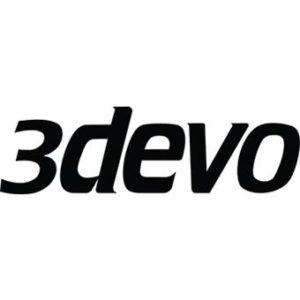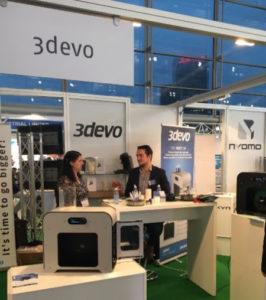 While 3D printing at the desktop may not have yet reached the sales that had been projected some years ago during the early maker craze, desktop 3D printing activity has certainly expanded far beyond the first generation of MakerBots that inspired smaller footprints for accessibility. Experts are not giving up on desktop units in this industry; many, rather, are turning more toward professional activities on desktop machines of all types. Even MakerBot has turned its attention to professional users, and we’ve seen industrial-quality machines for the desktop arising from companies such as Roboze, Ultimaker, FELIXprinters, and Rize. But what about the materials for these and other industrial machines?
While 3D printing at the desktop may not have yet reached the sales that had been projected some years ago during the early maker craze, desktop 3D printing activity has certainly expanded far beyond the first generation of MakerBots that inspired smaller footprints for accessibility. Experts are not giving up on desktop units in this industry; many, rather, are turning more toward professional activities on desktop machines of all types. Even MakerBot has turned its attention to professional users, and we’ve seen industrial-quality machines for the desktop arising from companies such as Roboze, Ultimaker, FELIXprinters, and Rize. But what about the materials for these and other industrial machines?
One company that has caught our eye here before is Netherlands-based 3devo, which has been seeking to provide industrial-grade filament production capabilities in a consumer-priced system — and desktop-sized footprint. Last week at formnext, I had the opportunity to speak with Tim Wesselink, the owner of 3devo, as well as Lisette van Gent, sales and marketing manager. While we have been keeping an eye on the company’s offerings, it was certainly refreshing to learn directly from those behind the technology the inspiration of their extrusion machines — and to see them in action.
The company, Wesselink told me, has been around for about a year formally, but the team have been working together closer to two years now, as the inspiration began in university among a group of mechanical engineers. The company, a subsidiary of Devoteq, sprang into being as the growing team wanted to figure out the best way to approach the market and a new place in it.
“3D printers are going to change everything,” Wesselink told me of the team’s inspiration to enter the market. “We thought filament extrusion could be enhanced. The market has broken open with affordability, such as when 3D printers came down from €100K to €2,000. With our background, we thought to make materials manufacturing as easy as consumer 3D printers, and to make pricing closer to desktop printers.”
The team had taken notice that materials pricing seemed to undermine some of the accessibility of the desktop market overall, and sought to bring their ideas to fruition.
“For some, we are a danger. We can explain to customers that you can buy pellets for a few euros per kilogram, rather than a spool of filament for €30,” he explained.
The NEXT 1.0 and 3devo Advanced filament extruders can take pellets of various materials — including PEEK, PVA, PA 12 (nylon), ABS, PLA, and many others (though advising against materials such as PVC and vulcanized rubbers) — and swiftly extrude them into usable 3D printing filament wound around a spool. The 3devo booth had two extruders operating throughout the show, and through my time at the booth I saw several spools finish off. The speed was notable, and the booth also featured several 3D printed objects that had been created using their filaments; these looked to be of comparable quality to any other 3D printed plastics I had seen.
Last year, 3devo attempted to get off the ground via a Kickstarter campaign — but this failed. And, as Wesselink stressed, that was a good failure for the company.
“A good product does not sell itself,” he told me the team learned of their to-that-point minimal approach to marketing. “It was good to not reach our goal. We’d had no idea on pricing, by about half. We would have gone bankrupt if we had succeeded. It was months after the Kickstarter that interest really started — so we kept going. But not as an engineering company. We looked into partnerships then, and went into production in about a year with someone from our private network. We are not a standard startup, we had no incubator. But we now have an experienced board, and can learn from their mistakes without repeating them.”
3devo, which maintains strong relationships with other Dutch companies, including Ultimaker and an undisclosed major multinational electronics company that has purchased several of their machines, is additionally turning toward new markets. The unnamed electronics company, for example, started with the purchase of one extruder and quickly turned around to order more because, said Wesselink, “the machine exceeded their expectations and provides the company with significant benefits.” BMW is also among 3devo’s customers. For its part, Ultimaker works alongside 3devo, providing extra spools for created filament and as the manufacturer of some of 3devo’s most commonly employed 3D printers. 3devo is seeing its most significant interest currently arising from the R&D sector, as well as universities.
The desktop extruding machines from 3devo retail for around €3,500 for the NEXT 1.0 Next Level, and around €4,000 for the Advanced Level. The machines are differentiated by their temperature ranges, as the Advanced offers a larger range of viable temperatures (up to 450° versus up to 350° on the Next Level). Both have dimensions of 506 x 216 x 448 mm (ex hopper), and have a 0.7 kg/hr capacity.
And for 3devo?
“So far it’s been a great adventure,” Wesselink told me.
We’ll certainly be keeping an eye on this up-and-coming extrusion company. Discuss in the 3devo forum at 3DPB.com.
[All photos taken by Sarah Goehrke for 3DPrint.com at formnext]Subscribe to Our Email Newsletter
Stay up-to-date on all the latest news from the 3D printing industry and receive information and offers from third party vendors.
You May Also Like
3D Printing Financials: Fathom Struggles in Financial Quicksand During Critical Transition
Facing a year of key transitions and financial pressures, Fathom (Nasdaq: FTHM) has filed its annual report for 2023 with the U.S. Securities and Exchange Commission (SEC). The document outlines...
Latest Earnings Overview for Australian 3D Printing Firms Titomic and AML3D
Australian 3D printing manufacturing firms Titomic (ASX: TTT) and AML3D (ASX: AL3) reported their financial results for the period from July to December 2023, marking the first half of their...
3D Printing Webinar and Event Roundup: April 7, 2024
Webinars and events in the 3D printing industry are picking back up this week! Sea-Air-Space is coming to Maryland, and SAE International is sponsoring a 3D Systems webinar about 3D...
3D Printing Financials: Unpacking Farsoon and BLT’s 2023 Performance
In the Chinese 3D printing industry, two companies, Farsoon (SHA: 688433) and Bright Laser Technologies, or BLT (SHA: 688333), have recently unveiled their full-year earnings for 2023. Farsoon reported increases...




































